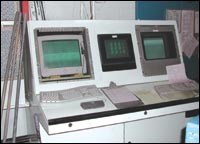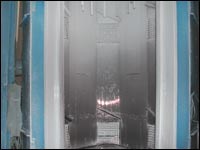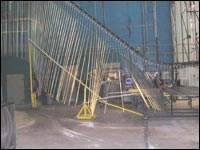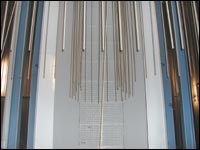A Homegrown Painting System
What is a homegrown painting system? At Indalex, it's one that has been tailored specifically to the company's needs…
Indalex (Gainesville, GA) is a major supplier of aluminum extrusions to the housing and construction industries. The company specializes in doors, windows and hurricane shutters.
During the last five years, Indalex' business has grown substantially, an average of 10% year over year. That increase means the paint line went from finishing 26 million lb of aluminum to 36 million lb.
Because of that boost in business, Indalex needed to add a second line to increase its finishing capability. When you ask Tommy Lee, director of maintenance services at Indalex, to describe the new line, he will tell you it's homegrown. The term homegrown may mean something different to each one of you reading this article, but to Mr. Lee it means a system that has been customized to Indalex' products, customers and needs.
Help from a Supplier
When it came time to design its new line, Indalex had some specific requirements:
- A reduction in VOCs emitted from the new paint line compared to the old line through a change in filter design;
- Paint booths oriented so that the operator could see into all four booths from one location;
- Elimination of chrome from the pretreatment system; and
- A cure time of 10 min at 350F so that Indalex could maintain its line speed of 20 fpm.
While Indalex knew what it wanted from its new paint line, the company needed a little help from a supplier to take those ideas and make them a functioning paint system. That supplier was Belco Industries, Inc., whom Indalex has worked with since 1987.
Perhaps the most pressing requirement from Indalex was the reduction in VOC emissions from the new line. The company's current air permit allowed Indalex to emit 100 tons of VOCs per year. In Georgia, if you go over your permit limit, you pay a penalty on the entire amount of VOCs emitted. Since Indalex was emitting 120-140 tons of VOCs per year, it had to pay some hefty penalties.
To meet Indalex' requirement, Belco engineered a single bank filter system to replace the conventional filter system used in most vertical cylindrical paint booths. This new design has dramatically improved the system's collection efficiency. The design also allows Indalex to use a dissolvable filter. "We are able to take our filters and throw them in a waste tank to dissolve. So, now we have no landfill charges," stated Mr. Lee.
Belco Industries, Inc. was also instrumental in assisting Indalex with the addition of an oxidizer. Indalex now traps 95% of the VOCs emitted from its new line. Those VOCs are either burned or returned to the paint line as air makeup. The company plans on connecting this oxidizer to its old line in the near future.
With this design, the new line emits less than 3.3 tons of VOCs per month compared to more than 10 tons of VOCs per month for the old line. The result is a huge savings in pollution control costs.
Another important, and tricky, requirement made by Indalex was the configuration of the four paint booths on the new line. Aluminum extrusions are typically painted using vertical cylindrical booths to accommodate the long lengths of most parts. Usually a line will have at least two booths that face opposite directions so that parts can be painted on both sides.
On its new line, Indalex wanted to create a "work cell" for the paint line operator - two booths would be on one side of the operator and two booths on the other side with the conveyor taking an overall "U" shape. However, if the typical design were used, then the operator would be able to see only two of the four booths at any one time. But, Belco was able to engineer a conveyor with a series of curves that allowed all four booths to face the same direction and, consequently, the paint line operator to see into all four booths from one location.
Indalex' requirements for the pretreatment system and the cure time were also met by Belco Industries, Inc. The elimination of chrome from the pretreatment system had a significant impact on costs. According to Jeff Rider, finishing manager at Indalex, "Our waste treatment costs on our old line were significant. But, on our new line there is no problem. We pretty much have nothing but rinse water."
Do It Yourself
The homegrown paint system at Indalex is certainly a product of the hard work of Indalex' suppliers, but it is just as much a result of the ingenuity of Indalex' employees. One way Indalex has helped to create its homegrown paint line is with its control system.
The control system started with the company's desire to know more about its paint flow. "If you go to any paint line, you control your paint flow by air pressure," explained Mr. Rider. "Well, 10 lb of air pressure today may give you more paint than 10 lb of air pressure tomorrow. It's hard to get consistency. We wanted to know how much paint was coming out of the head. That was our initial goal. Then it grew from there."
The control system is comprised of off-the-shelf items that Indalex purchased and installed itself. The system is used to measure and control a variety of process parameters (flow rate, stroke length, oven temperature, voltage, line speed, etc.) and monitor a number of quality control measures (mil thickness, cross hatch, color, pencil hardness, etc.).
Each of these values is then tied to an order number, die number and length. "As long as I have an order number, I can see exactly how they painted it, what the flow rates were and what all the results of the quality tests were," said Mr. Rider.
While this isn't unusual in the finishing industry, Indalex takes it a step further. "Any time a certain die, a certain length and a certain color are to be painted, the system goes back to the database and gets the best, last run when that die, that length and that color were painted and automatically sets all the parameters," continued Mr. Rider.
Throughout the plant, employees have access to the control system's database from a number of computer terminals. These terminals let employees access all information vital to processing that order, including part diagrams, color requirements, hanging positions and packaging instructions.
The benefit of all this is a high level of quality. "The beauty of the system that we have is that if we have a customer that is very high on quality it forces us not only to satisfy that customer's needs, but it also over satisfies everyone else. Now we have a complete consistency throughout the range of customers. Our goal is to satisfy the hardest to please customer. If we can meet his goals, then everybody downstream is going to get the same results," proclaimed Mr. Lee.
What Can We Do for You?
While Indalex has tweaked and modified its paint line through the years to arrive at that homegrown quality, the foundation of it all has been the one supplier the company has used for the installation of all its critical systems-Belco. "Our relationship with Belco has been excellent. They are always willing to get us the answers to our questions whether they are technical or process related," stated Mr. Lee.
"I don't know what's wrong with company's today. It's almost like it's hard to break into a new relationship. It's almost like, 'Yeah, we want your business, but this is what we offer. And you either take it or leave it.' Belco was the opposite of that. They listen to your ideas and they strive to provide you with the technology you ask for." Now, that's how you get a homegrown paint system.
Related Content
Coatings Plant Evolves with Market Trends
Expanding its focus from exclusively serving the RV industry, one of this company’s stand-alone coatings plant has successfully extended its services to additional markets.
Read MoreConcrete Reinforced Bars Built to Last
Not all corrosion-resistant materials for infrastructure are created equally. Epoxy-coated steel rebar has advantages that other materials used to prevent corrosion do not.
Read MoreFinishing Systems Provider Celebrates 150 Years, Looks to Future
From humble beginnings as an Indiana-based tin shop, Koch Finishing Systems has evolved into one of the most trusted finishing equipment providers in the industry.
Read MoreHenry Ford Is Still Right When It Comes to Color
Who would have imagined that more than 100 years after his famous statement about any color as long as it’s black would still have relevance of a sort?
Read MoreRead Next
Education Bringing Cleaning to Machining
Debuting new speakers and cleaning technology content during this half-day workshop co-located with IMTS 2024.
Read MoreDelivering Increased Benefits to Greenhouse Films
Baystar's Borstar technology is helping customers deliver better, more reliable production methods to greenhouse agriculture.
Read MoreEpisode 45: An Interview with Chandler Mancuso, MacDermid Envio Solutions
Chandler Mancuso, technical director with MacDermid Envio discusses updating your wastewater treatment system and implementing materials recycling solutions to increase efficiencies, control costs and reduce environmental impact.
Read More
.JPG;width=70;height=70;mode=crop)


















.jpg;maxWidth=300;quality=90)







